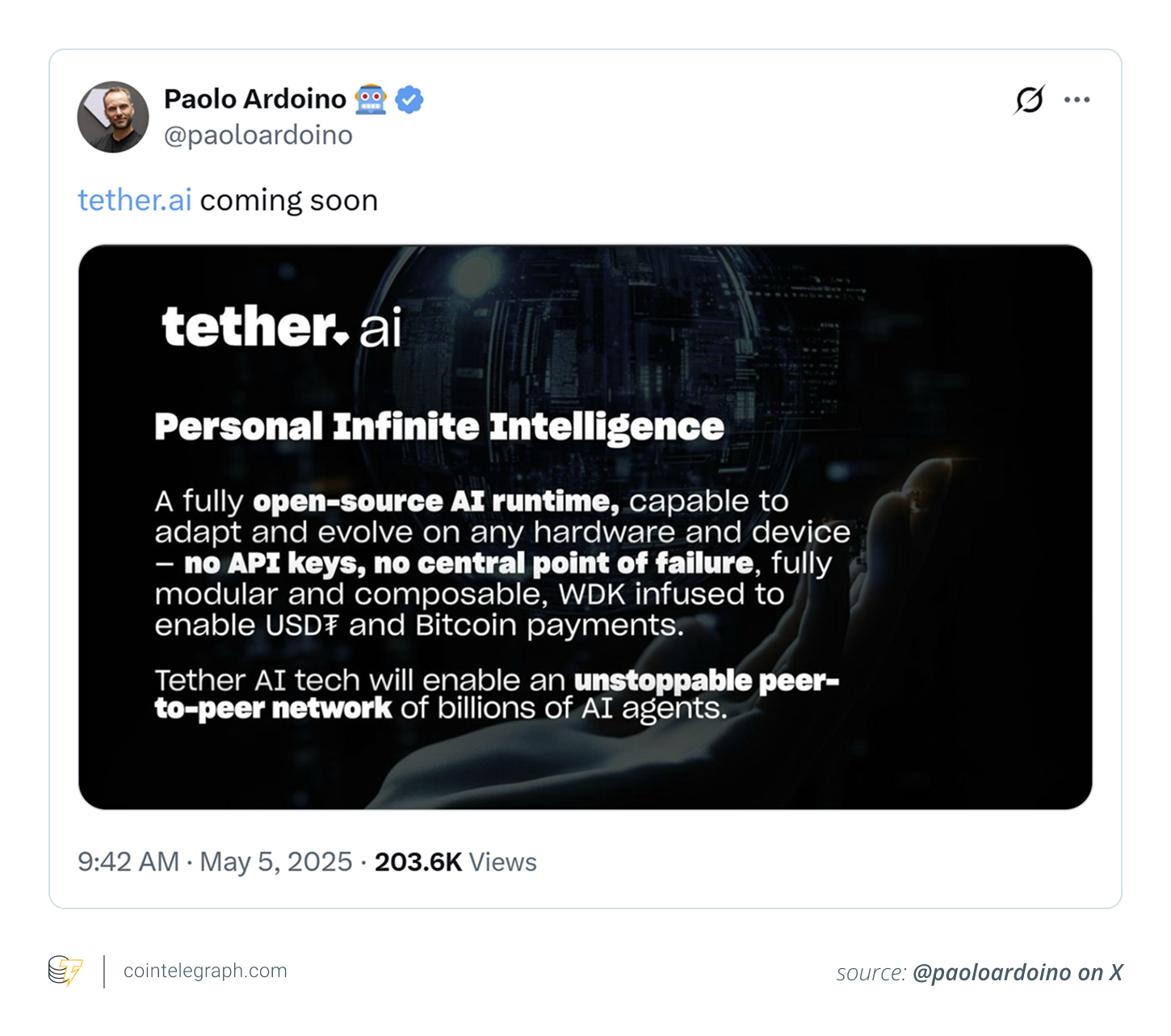Tether AI: What it is and why it matters for crypto and AI



What is Tether AI?
Tether AI is an open-source, decentralized artificial intelligence (AI) platform launched by Tether, the company behind the Tether USDt (USDT) stablecoin. Unlike traditional AI services that depend on centralized servers and require application programming interface (API) keys, Tether AI runs on a distributed peer-to-peer (P2P) network, offering enhanced privacy, autonomy and resilience.
Designed to be modular and composable, Tether AI can operate on any hardware, whether mobile, desktop or edge devices, without centralized control or a single point of failure.
A core innovation of Tether AI is its integration with cryptocurrency infrastructure. It natively supports Bitcoin (BTC) and USDt payments using Tether’s Wallet Development Kit (WDK), enabling seamless onchain transactions. This makes Tether AI one of the first AI platforms to offer direct crypto payment functionality at the protocol level.
According to Paolo Ardoino, CEO of Tether AI, it is a “fully open-source AI runtime, capable of adapting and evolving on any hardware and device, no API keys, no central point of failure, fully modular and composable, WDK-infused to enable USDT and Bitcoin payments.”

Ardoino said Tether AI’s primary objective is to create the “ideal technological foundation” for realizing the AI vision of Isaac Asimov, the celebrated science fiction author behind I, Robot and The Robot Series. In a separate post on X (written in Italian), Ardoino further asserted, “AI will, in the coming decades, become part of the very fabric of the universe.”
How Tether AI personalizes infinite intelligence
Tether AI is built around the AI runtime structure of “personal infinite intelligence,” which envisions customizable AI agents tailored to individual user needs and device capabilities. Developers can leverage Tether’s open-source WDK, launched in November 2024, to create mobile, desktop and web wallets with complete self-custodial control.
The platform enables native payments in USDt and Bitcoin to be processed directly over a peer-to-peer network, eliminating reliance on centralized payment processors.
It emphasizes user ownership, ensuring individuals control their assets without intermediaries. This decentralization-first model supports Tether’s mission of making AI accessible and censorship-resistant.
Ardoino has been critical of the AI industry’s dependence on centralized APIs and cloud platforms; Tether AI aligns with this mission.

The project will facilitate integrating native USDt and Bitcoin payments into autonomous systems and software agents. The objective is to create a decentralized, censorship-resistant foundation for AI tools.
Did you know? Tether AI CEO Paolo Ardoino favors locally executable AI models that can run directly on the user’s device, be it a smartphone or laptop, eliminating the need for third-party servers. This ensures that data stays local and allows for offline use.
How Tether AI brings decentralized intelligence to Keet and Pear
Tether AI is expected to integrate with Tether’s existing peer-to-peer ecosystem, including Keet, a decentralized messaging app, and Pear, a framework for building P2P applications. Initially unveiled in December 2024, the platform is slated for launch in 2025, marking Tether’s strategic entry into decentralized AI with embedded crypto functionality.
This initiative is part of a broader corporate shift announced in April 2024, which had Tether restructuring its operations to create dedicated units for AI and peer-to-peer technologies, such as Tether Data.
Tether is actively developing Tether AI and a suite of AI-powered applications. These include a real-time AI translation tool for international communication, a voice assistant for hands-free platform and application control, and a Bitcoin wallet assistant to streamline transaction management. Tether, under Ardoino, views AI as a cornerstone of technological advancement.
Tether’s AI expansion follows the company reporting $1 billion in operating profit for Q1 2025, mainly from US Treasury returns. With $149.3 billion in total assets and $5.6 billion in excess reserves, Tether remains dominant in the stablecoin sector. Its move into AI underscores a commitment to innovation, positioning the firm at the forefront of crypto and next-generation intelligent technologies
Did you know? Decentralized intelligence allows AI models to run across a network of devices instead of a single centralized server. This approach reduces the risk of data breaches, avoids single points of failure and gives users greater control over their data.
Key features of Tether’s WDK
Tether’s WDK, launched in November 2024, is an open-source framework designed to simplify the creation of self-custodial wallets across mobile, desktop and web platforms. The WDK empowers developers to build crypto wallets that support secure, peer-to-peer transactions without relying on centralized infrastructure.
Key features of the WDK include:
- Modularity: WDK has modules that enable developers to customize wallet functionalities based on specific use cases, including payments, storage or integration with decentralized applications (DApps).
- Pre-built components: WDK includes pre-built components for encryption, transaction management, key recovery and cross-platform compatibility, making it highly adaptable for beginners and advanced developers.
- User sovereignty: All wallets built using WDK enable full self-custody, meaning users retain exclusive control over their private keys and funds.
- Integration with other P2P technologies: WDK supports seamless integration with Tether’s other peer-to-peer technologies, including Keet and Pear.
In the context of Tether AI, WDK will play a critical role in embedding native crypto payments into decentralized AI applications, allowing automated agents and users to transact onchain with minimal friction. By bridging wallet development with AI and Web3 infrastructure, WDK advances Tether’s vision of a decentralized digital economy.
Did you know? In collaborative AI development, models are trained and improved by a global community without central ownership. This open-source approach can lead to fairer, more inclusive AI systems that are free from the biases or profit motives of centralized tech giants.
Implications of merging AI with blockchain are just beginning
Tether AI signals a transformative shift in how AI can be developed, deployed and monetized in a decentralized ecosystem. Blending AI capabilities with blockchain infrastructure and native crypto payments has enabled Tether to create applications that are not only intelligent but also financially autonomous and resistant to centralized control.
Tether AI will facilitate direct execution payments on peer-to-peer networks without any role for intermediaries. For developers, Tether AI opens up new avenues to build adaptive AI systems that run on any device, support real-time crypto payments and prioritize user sovereignty. For users, it means greater control over personal data, enhanced privacy and transparent interaction with AI services.
This paradigm challenges the dominance of cloud-based AI monopolies, offering an open-source alternative that can evolve with community input.
In the long term, Tether AI could influence sectors such as decentralized finance (DeFi), content moderation, Web3 gaming and autonomous economic agents. It positions AI not as a corporate product, but as a public utility — transparent, modular and composable — while integrated with crypto.
By merging AI with the trustless architecture of blockchain, Tether is pioneering a new class of decentralized digital infrastructure.